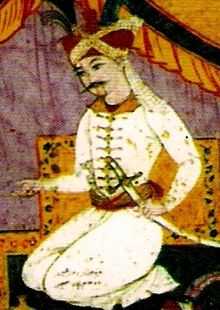Ismail II
| Shah Ismail II | |
|---|---|
| Shahanshah of Persia | |
 Artwork of Ismail II | |
| Reign | 1576–77 |
| Predecessor | Tahmasp I |
| Successor | Mohammad Khodabanda |
| Dynasty | Safavid |
| Father | Tahmasp I |
| Mother | Sultanum Begum Mawsillu |
| Born | 28 May 1537 [1] |
| Died | 24 November 1577 |
Ismail II (Persian: شاه اسماعیل دوم), (28 May 1537[2]– 24 November 1577); reigned 1576–77, was the third Safavid Shah of Iran.
Life
Ismail was the son of Shah Tahmasp I by an Iraqi Turkoman mother from the area of Mosul, Sultanum Begum Mawsillu.[3] In 1547, he was appointed governor of the province of Shirvan where he led several expeditions against the Ottomans. In 1556 he became governor of Khorasan but one of his father's leading courtiers, Masum Beg Safavi, convinced the shah that Ismail was plotting to overthrow him. Ismail spent the next 20 years in the prison at Qahqaheh Castle.[4]
When Tahmasp died in 1576, powerful Qizilbash army factions disputed the succession. The Qizilbash were split between the supporters of Ismail and those of his younger brother Heydar Ali, Tahmasp's son by a Georgian mother. The pro-Heydar faction were briefly successful at placing their candidate on the throne but Heydar was killed in a palace coup emerging from the fight between his supporters and their opponents. Another faction tried to crown Tahmasp's son by a Circassian woman, but Ismail's supporters defeated them and Ismail was finally crowned on 22 August 1576.[5]
In his campaigns in the Caucasus, he brought another 30,000 Georgians and Circassians captives to Iran, further setting on the program of creating a new layer in Persian society, which was already initiated by his father Tahmasp I.[6]
Ismail's years in prison seem to have affected his mind. As well as executing members of the faction who had opposed him, he also turned on some of his own supporters. He killed or blinded five of his own brothers and four other Safavid princes, including Ibrahim Mirza, so they would be unable to take the throne from him.
Described as being a "Sunni in sympathy,"[7] he also implemented a pro-Sunni policy and began reversing the imposition of Shi'ism in Iran (which he ultimately sought to abolish)[8] and appointed Sunni-leaning ulema.[9] One belief is that the aim of his pro-Sunni measures was to strengthen his own internal and external political position by appealing to the still strong Sunni sympathies of the Persian population and to placate the Ottomans.[10] The Qizilbash began to regret their choice of shah and plotted to assassinate Ismail with the help of his own sister Pari Khan Khanum. Ismail died after consuming poisoned opium on 24 November 1577.[11]
Ismail was a poet, painter and calligrapher, who supported the arts.[12]
Issue
- Prince Sultan Shoja al-din Mohammad Mirza (b. 16 October 1577 – d. 17 February 1578)
- Princess Safieh Sultan Beygom (b. 1555 – d. 3 September 1617)
- Princess Fakhr-i-Jahan Khanoum (b. 1577 – d. ?)
- Princess Gowhar Sultan Khanoum (b. 1578 – d. 1618)
See also
- Safavid conversion of Iran from Sunnism to Shiism
References
- ↑ Ismail II , Dr Manouchehr Parsadoost, ISBN 9643251063, 2003
- ↑ Ismail II , Dr Manouchehr Parsadoost, ISBN 9643251063, 2003
- ↑ Andrew J. Newman, Safavid Iran (IB Tauris, 2004) p. 42
- ↑ Savory p. 68.
- ↑ Savory p. 69.
- ↑ Oberling, Pierre, Georgians and Circassians in Iran, The Hague, 1963; pp.127-143
- ↑ Sinor, Denis, ed. (1990). Aspects of Altaic Civilization III: Proceedings of the Thirtieth Meeting of the Permanent International Altaistic Conference, Indiana University, Bloomington, Indiana, June 19-25, 1987. Psychology Press. p. 33. ISBN 9780700703807.
- ↑ Price, Massoume, ed. (1 Jan 2005). Iran's Diverse Peoples: A Reference Sourcebook (illustrated ed.). ABC-CLIO. p. 68. ISBN 9781576079935.
- ↑ Houchang Chehabi; Rula Abisaab (2006). Distant Relations: Iran and Lebanon in the Last 500 Years. I.B.Tauris. pp. 86–8.
- ↑ Andrew J Newman (11 Apr 2012). Safavid Iran: Rebirth of a Persian Empire. I.B.Tauris. p. 118. ISBN 9780857716613.
- ↑ Savory pp. 69–70
- ↑ Andrew J Newman (11 Apr 2012). Safavid Iran: Rebirth of a Persian Empire. I.B.Tauris. p. 47. ISBN 9780857716613.
Sources
- Newman, Andrew J. (2008). Safavid Iran: Rebirth of a Persian Empire. I.B.Tauris. pp. 1–281. ISBN 9780857716613.
- Babaie, Sussan (2004). Slaves of the Shah: New Elites of Safavid Iran. I.B.Tauris. pp. 1–218. ISBN 9781860647215.
- Roemer, H.R. (1986). "The Safavid period". The Cambridge History of Iran, Volume 6: The Timurid and Safavid periods. Cambridge: Cambridge University Press. pp. 189–351. ISBN 9780521200943.
| Ismail II Safavid Dynasty | ||
| Preceded by Tahmasp I |
Shah of Persia 1576–1577 |
Succeeded by Mohammad Khodabanda |
| ||||||